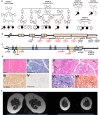GGPS1-associated muscular dystrophy with and without hearing loss
- PMID: 35869884
- PMCID: PMC9463955
- DOI: 10.1002/acn3.51633
GGPS1-associated muscular dystrophy with and without hearing loss
Abstract
Ultra-rare biallelic pathogenic variants in geranylgeranyl diphosphate synthase 1 (GGPS1) have recently been associated with muscular dystrophy/hearing loss/ovarian insufficiency syndrome. Here, we describe 11 affected individuals from four unpublished families with ultra-rare missense variants in GGPS1 and provide follow-up details from a previously reported family. Our cohort replicated most of the previously described clinical features of GGPS1 deficiency; however, hearing loss was present in only 46% of the individuals. This report consolidates the disease-causing role of biallelic variants in GGPS1 and demonstrates that hearing loss and ovarian insufficiency might be a variable feature of the GGPS1-associated muscular dystrophy.
© 2022 The Authors. Annals of Clinical and Translational Neurology published by Wiley Periodicals LLC on behalf of American Neurological Association.
Conflict of interest statement
None of the authors has any conflict of interest to disclose.
Figures

Similar articles
-
GGPS1 Mutations Cause Muscular Dystrophy/Hearing Loss/Ovarian Insufficiency Syndrome.Ann Neurol. 2020 Aug;88(2):332-347. doi: 10.1002/ana.25772. Epub 2020 Jun 18. Ann Neurol. 2020. PMID: 32403198 Free PMC article.
-
Expanding the phenotypic and genotypic spectrum of GGPS1 related congenital muscular dystrophy.Am J Med Genet A. 2024 Apr;194(4):e63498. doi: 10.1002/ajmg.a.63498. Epub 2023 Dec 21. Am J Med Genet A. 2024. PMID: 38129970
-
Genomic sequencing highlights the diverse molecular causes of Perrault syndrome: a peroxisomal disorder (PEX6), metabolic disorders (CLPP, GGPS1), and mtDNA maintenance/translation disorders (LARS2, TFAM).Hum Genet. 2020 Oct;139(10):1325-1343. doi: 10.1007/s00439-020-02176-w. Epub 2020 May 12. Hum Genet. 2020. PMID: 32399598
-
The Genetics of Atypical Femur Fractures-a Systematic Review.Curr Osteoporos Rep. 2021 Apr;19(2):123-130. doi: 10.1007/s11914-021-00658-y. Epub 2021 Feb 15. Curr Osteoporos Rep. 2021. PMID: 33587247 Free PMC article.
-
Recessive LOXHD1 variants cause a prelingual down-sloping hearing loss: genotype-phenotype correlation and three additional children with novel variants.Int J Pediatr Otorhinolaryngol. 2021 Jun;145:110715. doi: 10.1016/j.ijporl.2021.110715. Epub 2021 Apr 20. Int J Pediatr Otorhinolaryngol. 2021. PMID: 33892339 Review.
Cited by
-
Bi-allelic variants in HMGCR cause an autosomal-recessive progressive limb-girdle muscular dystrophy.Am J Hum Genet. 2023 Jun 1;110(6):989-997. doi: 10.1016/j.ajhg.2023.04.006. Epub 2023 May 10. Am J Hum Genet. 2023. PMID: 37167966 Free PMC article.
-
Effects of HMG CoA reductase (HMGCR) deficiency on skeletal muscle development.FEBS J. 2025 Jan 16:10.1111/febs.17406. doi: 10.1111/febs.17406. Online ahead of print. FEBS J. 2025. PMID: 39823152
-
GREGoR: Accelerating Genomics for Rare Diseases.ArXiv [Preprint]. 2024 Dec 18:arXiv:2412.14338v1. ArXiv. 2024. PMID: 39764392 Free PMC article. Preprint.
-
Whole-Genome Scanning for Selection Signatures Reveals Candidate Genes Associated with Growth and Tail Length in Sheep.Animals (Basel). 2024 Feb 22;14(5):687. doi: 10.3390/ani14050687. Animals (Basel). 2024. PMID: 38473071 Free PMC article.
-
Dynamic A-to-I RNA editing during acute neuroinflammation in sepsis-associated encephalopathy.Front Neurosci. 2024 Aug 2;18:1435185. doi: 10.3389/fnins.2024.1435185. eCollection 2024. Front Neurosci. 2024. PMID: 39156629 Free PMC article.
References
-
- Wang M, Casey PJ. Protein prenylation: unique fats make their mark on biology. Nat Rev Mol Cell Biol. 2016;17(2):110‐122. - PubMed
-
- Tucker EJ, Rius R, Jaillard S, et al. Genomic sequencing highlights the diverse molecular causes of Perrault syndrome: a peroxisomal disorder (PEX6), metabolic disorders (CLPP, GGPS1), and mtDNA maintenance/translation disorders (LARS2, TFAM). Hum Genet. 2020;139(10):1325‐1343. - PubMed
MeSH terms
Substances
Grants and funding
LinkOut - more resources
Full Text Sources
Medical
Molecular Biology Databases
